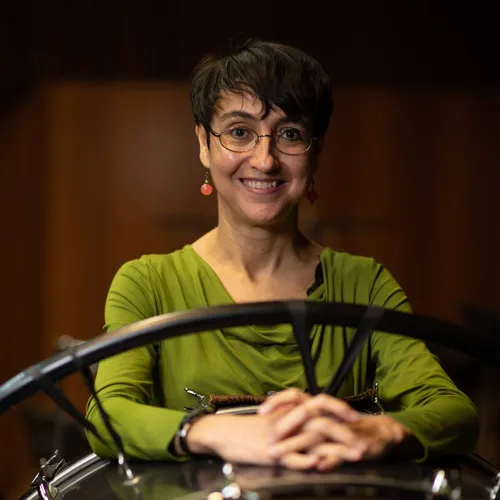
Elena Mendoza was born in Sevilla in 1973, whre she studied german linguistics. She then studied piano and composition in Zaragoza with Teresa Catalán, in Augsburg with John Van Buren, in Düsseldorf with Manfred Trojahn and in Berlin with Hanns Peter Kyburz at the Hochschule für Musik Hanns Eisler. After finishing studies she was a fellow at different institutions, like Ensemble Modern Akademie in Frankfurt a.M. or Academy Schloß Solitude in Stuttgart. Currently she lives in Berlin, where she is a composition Professor at the Universität der Künste.
She is particularly interested in timbrical and dramaturgical questions and has particular preferences for theatrical concepts touching on language, space and music. From these emerged in 2007 the music-theater production "Niebla" (Europäisches Zentrum der Künste in Dresden Hellerau), written in close cooperation with the director Matthias Rebstock and setting new music-theatre standards. On behalf of Gerard Mortier they also created "La ciudad de las mentiras", based on textes by Juan Carlos Onetti, for the Teatro Real Madrid. Their most recent project in common "Der Fall Babel", a commission from Schwetzinger Festspiele, was premiered in April 2019 with great succes.
She has worked with many renowned performers such as ensemble recherche, Klangforum Wien, Ensemble Modern, Vogler-Quartett, Ensemble Mosaik, Ensemble emex, Ensemble Taller Sonoro, Neue Vocalsolisten Stuttgart, Schola Heidelberg, KNM Berlin, WDR Sinfonieorchester, Orquesta nacional de España, Philharmonisches Orchester Freiburg, Orquesta Sinfónica de Madrid, Real Orquesta Sinfónica de Sevilla and many others. With the Ensemble Ascolta in Stuttgart she helds a particularlly close relationship since years. Her music has been presented in festivals such as Biennale Salzburg, Ars Musica Brussels, Wittener Tage für neue Kammermusik, Eclat Stuttgart, MärzMusik Berlin, Dresdner Tage der Zeitgenössischen Musik, Ultraschall Berlin, Mixtur Barcelona, Acanthes Metz, Steirischer Herbst Graz, Schloßmediale Werdenberg, Musica Viva München, Schwetzinger Festspiele or rainy days Luxembourg. She has received numerous awards, such as the Spanish Premio Nacional de Música 2010, the Musikpreis Salzburg 2011, the Kunstpreis Berlin 2017, the Heidelberger Künstlerinnenpreis 2019 or just recently the Christoph and Stephan Kaske Stiftung Prize.
Her discography includes two portrait CDs, one with instrumental chamber music on the label Kairos (2008), and another with scenes of "Niebla" followed by "Fe de erratas" and "Gramática de lo indecible" on the Wergo/Deutsche Musikrat collection (2011).
From 2009 on her scores are published by edition Peters.
Stilleben (literally "still life" or "quiet life") is the German term for still life in painting.
Throughout the history of art we find representations of domestic objects such as kitchen utensils, food, books, etc. which, through composition, colour and light, acquire an aesthetic dimension and transcend the everyday. In my work Stilleben mit Orchester I have transferred this pictorial idea to the acoustic field, so that we will find sounds of multiple everyday objects sublimated through their instrumentation in the large body of the orchestra.
The exploration of the timbral possibilities of objects has been with me for several years now, as my latest works (e.g. the musical theatre "Der Fall Babel" from 2019) testify. With the outbreak of the pandemic, however, this interest in the poetics of the everyday has taken on a new dimension: our life experiences have long been confined to our own four walls, where, as if through a microscope, we have been forced to discover new worlds in small things. This is where the literal translation of "Stilleben" as still or quiet life comes into play - in Stilleben mit Orchester we are witnessing a musical world that is to some extent "quiet" and intimate, which is also due to the nature of the objects themselves, which are not designed to make music and therefore do not have a resonating body to amplify them like traditional musical instruments.
Another aspect that interests me in this work is the questioning of the concert hall as a closed universe. The integration of everyday objects, which are "aliens" in the relatively hermetic context of a symphony orchestra, implies from a performative and visual point of view a dramaturgical conflict, a culture clash that invites us to look and listen to the orchestra from an unusual perspective.